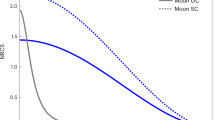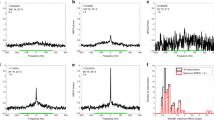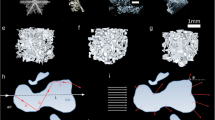Abstract
RADAR is a powerful technique for probing the surfaces and subsurfaces of Solar System bodies. Inner Solar System bodies reflect radar in an almost specular fashion, with low reflectivity and little polarization. The icy satellites of Jupiter, by contrast, show high reflectivities, diffuse scattering laws and unusual polarization properties1: compared with what would be expected for specular reflection, there is 1.5 times as much power reflected in the unexpected sense of circularly polarized radar as in the expected sense, and half as much power in the unexpected as in the expected sense of linear polarization. According to the coherent backscatter model2, most of the received power from icy satellites is multiply reflected by particles about a wavelength in size located randomly under the surface of the regolith. We have constructed a laboratory analogue of this model by reflecting laser light off polystyrene beads suspended in water, and find that this model reproduces the unusual polarization ratios observed in the radar data. This implies that the regoliths of icy satellites are weakly absorbing matrices of small refractive index containing imbedded scatterers separated by distances of the order of a wavelength. No structures of special shape or other geometrical or optical properties are required.
This is a preview of subscription content, access via your institution
Access options
Subscribe to this journal
Receive 51 print issues and online access
$199.00 per year
only $3.90 per issue
Buy this article
- Purchase on Springer Link
- Instant access to full article PDF
Prices may be subject to local taxes which are calculated during checkout
Similar content being viewed by others
References
Ostro, S. in Satellites of Jupiter (ed. Morrion, D.) 213–236 (University of Arizona Press, Tucson, 1982).
Hapke, B. Icarus 88, 407–417 (1990).
Goldstein, R. & Green, R. Science 207, 179–180 (1990).
Hagfors, T., Gold, T. & lerkic, H. Nature 315, 637–640 (1990).
Ostro, S. & Shoemaker, E. Icarus 85, 335–345 (1990).
MacKintosh, F. & John, S. Phys. Rev. B37, 1884–1897 (1988).
Kerker, M. The Scattering of Light and Other Electromagnetic Radiation (Academic, New York, 1969).
Bohren, C. & Huffman, D. Absorption and Scattering of Light by Small Particles (Wiiey, New York, 1983).
Clark, R., & McCord, T. Icarus 41, 323–339 (1980).
Gold, T., O'Leary, B. & Campbell, M. Proc. 2nd Lunar Planet Sci. Conf. 2173–2181 (1971).
Ostro, S., Resema K., Campbell, D., Chandler, J. & Shapiro, I. Bull. Am. Astr. Soc. 22, 1109 (1990).
Muhleman, D., Grossman, A., Butler, B. & Slade, M. Science 248, 975–980 (1990).
Cuzzi, J. & Pollack, J. Icarus 33, 233–262 (1978).
Brown, R. & Cruikshank, D. Icarus 55, 83–92 (1983).
Domigue, D., Hapke, B., Lockwood, G. & Thompson, D. Icarus 90, 30–42 (1991).
Author information
Authors and Affiliations
Rights and permissions
About this article
Cite this article
Hapke, B., Blewett, D. Coherent backscatter model for the unusual radar reflectivity of icy satellites. Nature 352, 46–47 (1991). https://doi.org/10.1038/352046a0
Received:
Accepted:
Issue Date:
DOI: https://doi.org/10.1038/352046a0
This article is cited by
-
A continuum of icy satellites’ radar properties explained by the coherent backscatter effect
Nature Astronomy (2023)
Comments
By submitting a comment you agree to abide by our Terms and Community Guidelines. If you find something abusive or that does not comply with our terms or guidelines please flag it as inappropriate.



